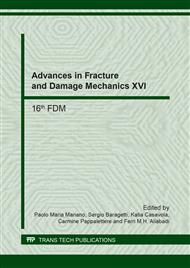[1]
Mishra, R.S. and Z.Y. Ma, Friction stir welding and processing. Materials Science and Engineering: R: Reports, 2005. 50(1-2): pp.1-78.
Google Scholar
[2]
Lee, W. -B. and S. -B. Jung, The joint properties of copper by friction stir welding. Materials Letters, 2004. 58(6): pp.1041-1046.
DOI: 10.1016/j.matlet.2003.08.014
Google Scholar
[3]
Padmanaban, G. and V. Balasubramanian, Selection of FSW tool pin profile, shoulder diameter and material for joining AZ31B magnesium alloy–an experimental approach. Materials & Design, 2009. 30(7): pp.2647-2656.
DOI: 10.1016/j.matdes.2008.10.021
Google Scholar
[4]
Cioffi, F., et al., Friction stir welding of thick plates of aluminum alloy matrix composite with a high volume fraction of ceramic reinforcement. Composites Part A: Applied Science and Manufacturing, 2013. 54: pp.117-123.
DOI: 10.1016/j.compositesa.2013.07.011
Google Scholar
[5]
Fernández, J.R. and A.J. Ramirez. Dissimilar friction stir welding of steel to Ni-based alloy 625-Butt and lap joints. in The Twenty-third International Offshore and Polar Engineering Conference. 2013. International Society of Offshore and Polar Engineers.
Google Scholar
[6]
Bagheri, A., T. Azdast, and A. Doniavi, An experimental study on mechanical properties of friction stir welded ABS sheets. Materials & Design, 2013. 43: pp.402-409.
DOI: 10.1016/j.matdes.2012.06.059
Google Scholar
[7]
Campanelli, S.L., et al., Analysis and comparison of friction stir welding and laser assisted friction stir welding of aluminum alloy. Materials, 2013. 6(12): pp.5923-5941.
DOI: 10.3390/ma6125923
Google Scholar
[8]
Fratini, L., G. Buffa, and R. Shivpuri, In-process heat treatments to improve FS-welded butt joints. The International Journal of Advanced Manufacturing Technology, 2008. 43(7): p.664.
DOI: 10.1007/s00170-008-1750-8
Google Scholar
[9]
Donne, C.D., et al. Investigations on residual stresses in friction stir welds. in 3Õrd International Symposium on Friction Stir Welding. (2001).
DOI: 10.1533/9781845697716.2.215
Google Scholar
[10]
Peel, M., et al., Microstructure, mechanical properties and residual stresses as a function of welding speed in aluminium AA5083 friction stir welds. Acta Materialia, 2003. 51(16): pp.4791-4801.
DOI: 10.1016/s1359-6454(03)00319-7
Google Scholar
[11]
Casavola, C., et al., Influence of the clamps configuration on residual stresses field in friction stir welding process. The Journal of Strain Analysis for Engineering Design, 2015: p.0309324715573361.
DOI: 10.1177/0309324715573361
Google Scholar
[12]
Casavola, C., et al., Temperature field in FSW process: experimental measurement and numerical simulation, in Experimental and Applied Mechanics, Volume 6. 2015, Springer International Publishing. pp.177-186.
DOI: 10.1007/978-3-319-06989-0_24
Google Scholar
[13]
Casavola, C., et al., Numerical Prediction of Temperature and Residual Stress Fields in LFSW, in Residual Stress, Thermomechanics & Infrared Imaging, Hybrid Techniques and Inverse Problems, Volume 9. 2016, Springer International Publishing. pp.263-273.
DOI: 10.1007/978-3-319-21765-9_32
Google Scholar
[14]
Casavola, C., A. Cazzato, and V. Moramarco. Thermographical analysis of friction stir welding and laser assisted friction stir welding. in Proc. 13th Youth Symp. on 'Experimental solid mechanics. Decın, Czech Republic. (2014).
DOI: 10.5772/intechopen.72271
Google Scholar
[15]
Papahn, H., P. Bahemmat, and M. Haghpanahi, Effect of cooling media on residual stresses induced by a solid-state welding: underwater FSW. The International Journal of Advanced Manufacturing Technology, 2016. 83(5-8): pp.1003-1012.
DOI: 10.1007/s00170-015-7653-6
Google Scholar


